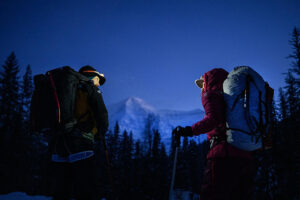Simon Messner called it a “dream come true”. Indeed, climbing the near-mythical North Face of the Matterhorn, following in the footprints of legendary alpinist Walter Bonatti, is the stuff of dreams for many mountaineers. Messner and Martin Sieberer achieved that dream in style. They made it from Zermatt to the summit in just 19 hours, topping out at 11 pm.
Sieberer called it an “incredible adventure/torture”.

Believe it or not, this is their Matterhorn summit picture, complete with a full moon. Photo: Martin Sieberer
Whatever the route, the Matterhorn is one of the most coveted peaks in the Alps. The North Face, however, is legendary. It is also one of the six great North Faces of the Alps.
Italian ace Water Bonatti climbed the first direct route in 1965, 100 years after the peak’s first ascent. He did it in grand style too: in winter, solo. Since then, the route has become a testing ground for first-class climbers, locals and visitors alike. Sieberer and Messner were no exception. The South Tyrolean pair had planned their ascent thoroughly and hoped to put their own spin on the ascent.
When the conditions felt right, they took the first train from Täsch to Zermatt and immediately set off. They left town at 4:15 am and reached the face five hours later.
“That’s usually way too late to start climbing such a mountain, but as conditions seemed ok, we continued,” Messner said.
The climb
They climbed unroped to save time until they reached the infamous Angel’s Traverse: “Here the terrain became more complex and we decided to rope up,” Messner noted.

The climbers took advantage of good conditions. Photo: Simon Messner
“We made good time, but as temperatures were low, the liquid in our bottles was frozen solid. So we couldn’t drink a single sip during the whole climb, making us very tired,” Messner wrote. He went on to describe the climb:
“Our calves burned like hell as we climbed higher and higher, over black and very hard alpine ice, and passages of fragile rock, but we had no time to lose…As we found no spot for a bivy, there was just one possibility for us: keep going!
“When we reached the icefall on the upper part of the classic North Face, night set in.
“We continued by the light of our headlamps. Meanwhile, our thirst was almost unbearable! In the dark, we missed the original exit to the Zmutt-ridge, forcing us to climb straight to the summit, which we reached shortly before midnight.”
Despite the remarkably swift climb, Sieberer admitted that they had “underestimated the exhaustion after 3,000 vertical metres.” The descent was therefore a struggle for the very tired and thirsty climbers. To make matters worse, Sieberer’s headlamp stopped working at the summit.
“Eventually, we made it back to the Solvay Hut at around 2:00 am,” Sieberer recalled.
All the beds were occupied, so they melted some snow to get water. “The first liquid after so many hours felt like heaven,” Messner said. Then, he added, “we slept happily on the dirty floor.”

Simon Messner. Photo: Simon Messner
An elated Simon Messner was keen to remember Bonatti’s achievement. “[He] opened this fantastic route in 1965, solo and in winter over several days. A mental challenge beyond comparison!”






